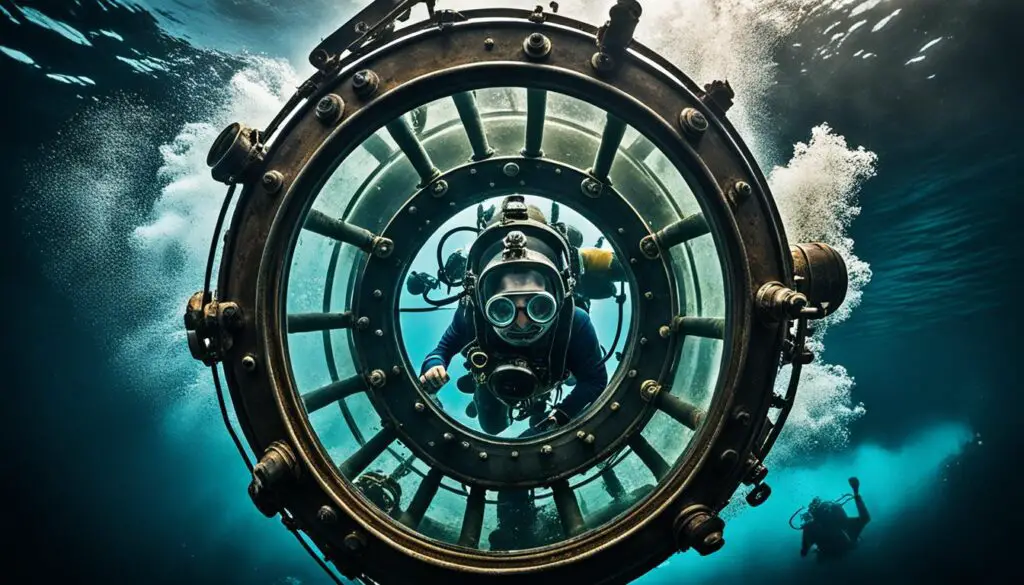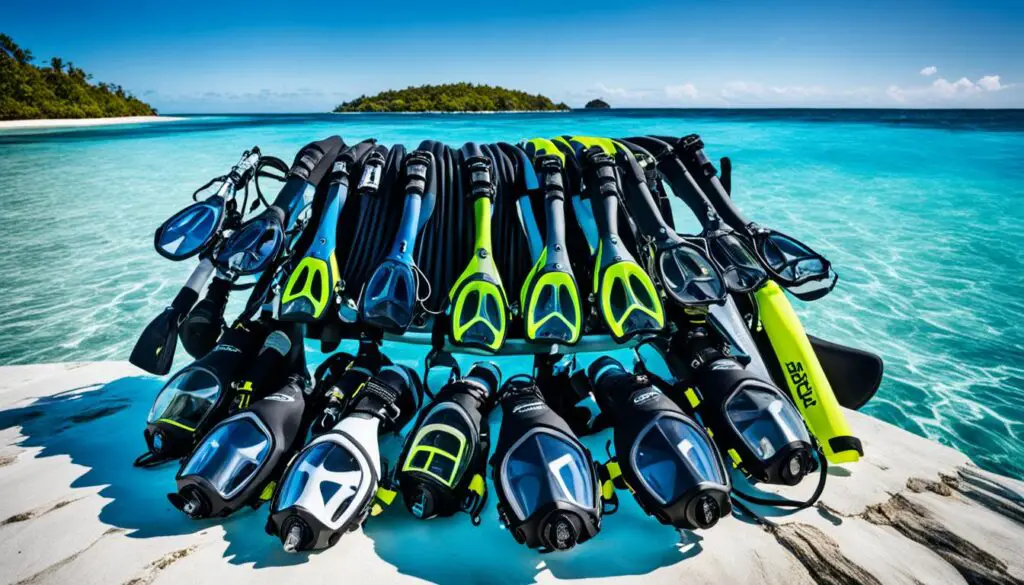Diving has changed a lot over time. Now, with new wireless tech, explorers like me can make the most of our underwater journeys. We no longer depend on old diving ways but enjoy a full suite of modern tools.
The dive world has grown from diving bells to scuba and dive computers. These add-ons have turned diving into a safer, funner, and more efficient activity.
Think about diving without wires holding you back. With today’s wireless dive gear, we enjoy a free, easy dive. This includes wireless dive computers or chatting with friends underwater. Going wireless is a big plus for divers.
But the cool stuff isn’t just wireless. Essential gear like BCDs, regulators, masks, and tanks are key to a great dive. These items help us breathe, adjust our depth, and keep us warm, offering the perfect dive experience.
For me, each dive is a chance for a new adventure. Whether it’s vibrant coral or old wrecks, having top gear is vital. Dive tech keeps getting better, and I’m all in for the wireless wave, ready to elevate my dive game.
Key Takeaways:
- Modern diving is all about wireless tech for an improved underwater experience.
- Wireless features like dive computers and communication systems are essential today.
- BCDs, regulators, tanks, and more are crucial for a comfortable and safe dive.
- Having the right gear ensures a pleasant dive every time.
- Adopting wireless tech makes diving even more exciting.
Historical Diving Technology
Diving technology made big strides from the 1600s’ diving bells to today. These were wood or metal containers turned upside down underwater. They were heavy and sank to the sea floor. Edmund Halley created one with a window, making undersea exploration easier for almost 100 years.
“The diving bell, which was sunk and brought up by means of big ropes, had a wooden container for those who went down in it, and its descending was to the depth of four or five fathoms” – Edmund Halley
Then, compressed air systems came around. They let divers breathe longer under the surface. This was huge for underwater exploration. With more air and freedom, divers went deeper than ever before.
In 1943, scuba diving was born thanks to Jacques Cousteau and Emil Gagnan. It stands for “self-contained underwater breathing apparatus.” Now, divers could breathe from tanks of air and stay underwater longer. This was a game-changer, opening up new depths to explore.
The Invention of Scuba Diving
“The sea, once it casts its spell, holds one in its net of wonder forever.” – Jacques Cousteau
Scuba diving allowed people to get up close with the sea. It helped us learn more about marine life and oceans. Cousteau’s love for the sea and work in conservation inspired generations to protect our oceans.
Dive computers are vital in diving today. They show depth, time, and when to stop diving. Because of them, diving has become safer. They help divers plan their trips to the bottom sea more accurately.
| Historical Diving Technology | Key Features |
|---|---|
| Diving Bells | Air spaces created within inverted containers |
| Compressed Air Systems | Extended underwater breathing capability |
| Scuba Diving | Safe breathing from compressed air tanks |
| Dive Computers | Depth, time, and decompression information |

Essential Dive Gear
To have a safe and enjoyable dive, it’s key to have the right gear. This is important for both new and seasoned divers. Now, let’s look at what gear every diver needs.
Buoyancy Control Device (BCD)
A BCD helps divers control their position in the water. It has an inflatable part for adjusting buoyancy at different depths. The BCD also lets divers attach other important gear.
Scuba Regulator
The scuba regulator manages gas pressure from the tank for safe breathing. It gives a steady air supply, making diving comfortable. A high-quality regulator is crucial for safety and fun.
Dive Mask
A dive mask is vital for clear vision under the water. It keeps water out and offers a good view. Look for a mask that fits perfectly and is made of strong materials.
Dive Fins
Dive fins help you move in the water by adding propulsion. They come in different types, so find a pair that fits well and allows easy movement. This helps save your energy during dives.
Weights and Belts
Weights and belts help you stay at the right depth in the water. They balance the natural buoyancy you get from your diving suit. Making sure your weights are set up correctly is important for safe diving.
Diving Tank
The diving tank holds the air you breathe underwater. It is usually made of aluminum or steel in different sizes. A valve on the tank connects to your regulator for air supply.
Dive Computer
A dive computer is a must for planning and checking your dive. It shows depth, time, and safety stops without manual work. This reduces the risk of sickness from diving too deep.
Diving Suit
A diving suit keeps you warm and protects against the water. There are wetsuits, drysuits, and semi-dry suits. Find one that fits well and keeps you warm and safe in the water.
Quality dive gear is essential for safety and a great dive adventure. Each item is important for your comfort, safety, and enjoyment underwater.

| Essential Dive Gear | Description |
|---|---|
| Buoyancy Control Device (BCD) | Controls neutral buoyancy underwater and provides attachment points for other gear. |
| Scuba Regulator | Regulates the pressure of gas in the diving tank, delivering breathable air to the diver. |
| Dive Mask | Provides clear underwater vision by creating an air space in front of the eyes. |
| Dive Fins | Enhances movement underwater by providing propulsion and maneuverability. |
| Weights and Belts | Control buoyancy by counterbalancing the buoyancy from exposure suits and equipment. |
| Diving Tank | Holds the compressed air mixture for breathing underwater. |
| Dive Computer | Provides real-time information about depth, time, and decompression stops for safe diving. |
| Diving Suit | Maintains body temperature and protects against the underwater environment. |
Conclusion
Diving technology is getting better each day, offering wireless gear for divers. This tech, like dive computers and dive lights, makes our time underwater safe and fun. It ensures we have the best tools for our diving adventures.
For any dive, having the correct gear is key. Now, with diving wireless tech, staying in touch underwater is easy. It keeps us updated and connected with other divers, making diving safer and more fun.
I absolutely love the new diving wireless technology. It lets me dive with confidence, knowing I have everything I need. Exploring the oceans is thrilling, and I’m excited to see where this tech takes us next.
FAQ
What are the must-have dive features for modern explorers?
Modern explorers need diving wireless technology for better adventures. They also require essential gear like a buoyancy control device and a scuba regulator. Other important items include a dive mask, fins, weights, tanks, a computer, and a diving suit.
What is historical diving technology?
Historical diving technology covers early methods of underwater exploration. This includes diving bells, compressed air systems, and the advent of scuba diving. Dive computers were also a key part of this history.
What gear is essential for diving?
Key gear for divers includes a buoyancy control device and a scuba regulator. A dive mask for clear vision and fins for efficient swimming are crucial. Also vital are dive weights and belts, a diving tank, a computer, and a diving suit for warmth.
How has diving technology evolved over the years?
Diving technology has seen remarkable development. It started with diving bells and advanced to compressed air systems. Scuba diving and dive computers were major breakthroughs. Today, wireless equipment offers real-time updates and improved visibility for divers.
